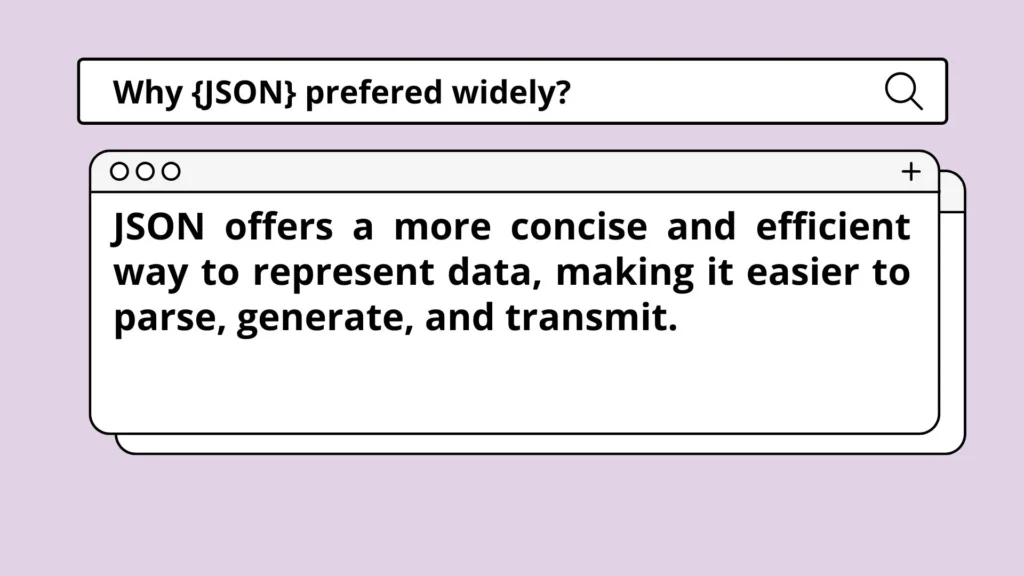Why JSON?
Wondering Why JSON took every other format

In this blog we will look into
High Compatibility
JSON’s language-independent nature makes it an ideal format for exchanging data between different programming languages and platforms. For example, a Java application can easily send JSON data to a Python program, and a mobile app built with JavaScript can use JSON to communicate with a PHP back-end server. This is because both systems can readily parse and generate JSON. It is compatible with numerous programming languages, frameworks, operating systems, and browsers, all of which can utilize JSON straight “out of the box.
Outside of web development, JSON is commonly used within applications and IT systems to store and manage configuration settings. For instance, JSON configuration files can hold critical information like database connection details, API keys, or user preferences. The simplicity and readability of JSON allow developers to adjust application settings easily, without needing to alter the underlying code.
Human readable
It is a text-based format designed for storing and exchanging data in a manner that is both human-readable and machine-parsable. This makes JSON straightforward to learn and easy to troubleshoot. JSON’s simplicity and flexibility have contributed to its widespread adoption across various programming languages and platforms. Its lightweight structure allows for efficient data transfer, making it ideal for web applications and APIs. Unlike more complex formats, JSON requires minimal overhead, resulting in faster processing and reduced bandwidth usage. Furthermore, JSON’s compatibility with JavaScript has made it the go-to choice for many front-end developers, streamlining the integration of data into web applications. Its ability to represent complex data structures, including nested objects and arrays, provides developers with the versatility needed to handle diverse data types. The self-describing nature of JSON also enhances its usability, as the data structure is evident from the format itself. This characteristic not only aids in debugging but also facilitates data exploration and analysis. Additionally, JSON’s widespread support in various programming languages means that developers can easily work with it regardless of their preferred technology stack.
JSON took over XML and CSV
Compared to CSV, JSON provides a more structured and hierarchical approach to data representation, allowing for the capture of complex relationships and nested information. This flexibility has made JSON the preferred choice for modern data-driven applications and the exchange of rich, structured data.
The statistics speak for themselves – according to industry reports, JSON has surpassed XML as the most commonly used data format, with a significant majority of web services and APIs now supporting JSON as their primary data exchange mechanism. This shift towards JSON is not without reason. Its lightweight structure and ease of use make it more efficient for data transmission, resulting in faster load times and improved performance for web applications.
Developers appreciate JSON’s simplicity and readability, which streamlines the coding process and reduces the likelihood of errors. Furthermore, JSON’s compatibility with JavaScript, the dominant language for front-end web development, has cemented its position as the go-to choice for modern web applications. The widespread adoption of JSON has also led to the development of robust tools and libraries across various programming languages, further enhancing its versatility and appeal. As more organizations recognize the benefits of JSON, we’re seeing a ripple effect throughout the tech industry, with many legacy systems being updated to support JSON integration. This trend is likely to continue, solidifying JSON’s position as the de facto standard for data interchange in the foreseeable future.
Language Independent
JSON’s language-independent nature makes it an excellent format for exchanging data between different programming languages and platforms. As a result, many databases have been developed to store and exchange data in JSON. format. These JSON-based databases, often referred to as document-oriented or NoSQL databases, offer several advantages over traditional relational databases. One key benefit is their flexibility in handling unstructured or semi-structured data. Unlike rigid relational schemas, JSON databases can easily accommodate evolving data models without requiring complex migrations. This adaptability is particularly valuable in agile development environments where requirements frequently change. Moreover, JSON databases typically provide better performance for read-heavy workloads, as they can retrieve entire documents in a single operation. This eliminates the need for complex joins across multiple tables, resulting in faster query execution times. Scalability is another strength of JSON databases. Many of these systems are designed to scale horizontally, allowing for distributed data storage and processing across multiple servers. This architecture enables them to handle large volumes of data and high concurrent user loads more efficiently than traditional relational databases.
Space Saving
Easy to read
The “key/value pair” format of JSON syntax is simple for both humans and computers to interpret and convert. This simplicity leads to widespread adoption across various programming languages and platforms. JSON’s lightweight structure allows for efficient data transfer, making it ideal for web applications and APIs. Its flexibility enables the representation of complex data structures, including nested objects and arrays, without sacrificing readability. Moreover, JSON’s compatibility with JavaScript makes it particularly advantageous for web development, as it can be easily parsed and manipulated within browsers. This seamless integration reduces the need for data conversion, streamlining the development process and improving overall performance. The format’s popularity has also led to extensive tool support, with numerous libraries and utilities available for working with JSON data. This ecosystem further enhances its appeal, allowing developers to quickly implement JSON-based solutions in their projects.